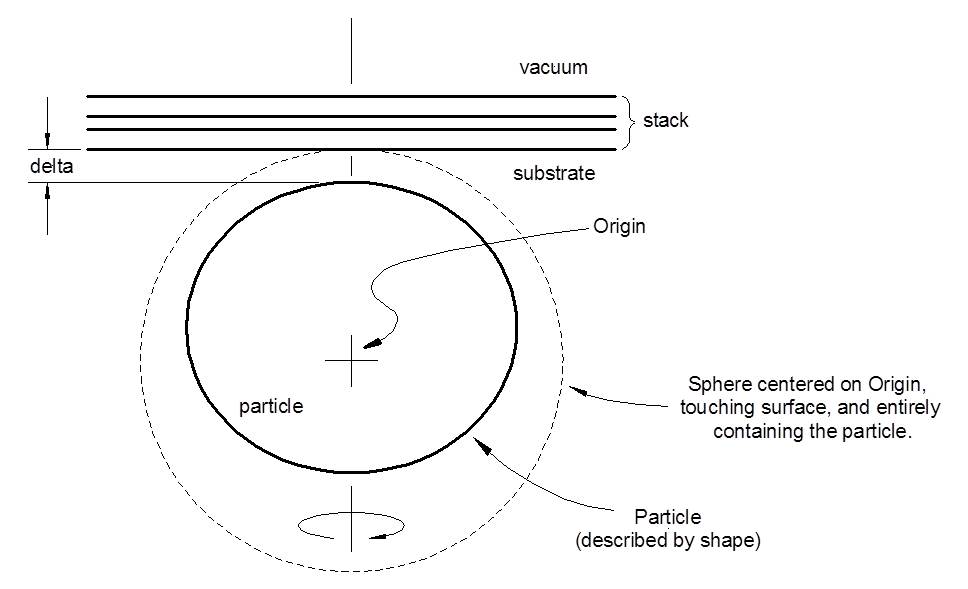class Subsurface_Axisymmetric_Particle_BRDF_Model
The Subsurface_Axisymmetric_Particle_BRDF_Model implements the theory of Bobbert and Vlieger for the scattering by a sphere in a substrate, extended for an axisymmetric particle. The theory of Bobbert and Vlieger requires that the particle be wholly contained inside a sphere centered on the origin and touching the lowest interface of the substrate film stack. There are conditions under which the theory will not be valid for axisymmetric particles. It is important that the user check the model for convergence over the polar and azimuthal harmonic orders. If the routines do not appear to converge, none of the results should be considered accurate. The substrate must be non-absorbing.
Parameters:
| Parameter | Data Type | Description | Default |
|---|---|---|---|
| lambda | double | Wavelength of the light
in vacuum [µm]. (Inherited from BRDF_Model.) |
0.532 |
| type | int |
Indicates whether the light is incident from above the
substrate or from within the substrate and whether the
scattering is evaluated in reflection or transmission.
The choices are: 0 : Light is incident from the above the substrate, and scattering is evaluated in reflection. 1 : Light is incident from the above the substrate, and scattering is evaluated in transmission. 2 : Light is incident from the within the substrate, and scattering is evaluated in reflection. 3 : Light is incident from the within the substrate, and scattering is evaluated in transmission. For 1, 2, and 3, the substrate must be non-absorbing. (Inherited from BRDF_Model). |
0 |
| substrate | dielectric_function | The
optical constants of the substrate, expressed as a
complex number (n,k) or, optionally, as a function of
wavelength. The substrate must be non-absorbing. (Inherited from BRDF_Model.) |
(4.05,0.05) |
| density | double | The
surface number density of local scatterers
[µm]. (Inherited from Local_BRDF_Model.) |
1 |
| Shape | Axisymmetric_Shape | The shape and size of the particle. | Ellipsoid_Axisymmetric_Shape |
| particle | dielectric_function | The optical constants of the particle, expressed as a complex number (n,k) or, optionally, as a function of wavelength. | (1.59,0) |
| stack | StackModel_Ptr | Description of any stack of coatings on the particle. | No_StackModel |
| delta | double | The distance between the particle and the substrate [µm]. This value is zero when the particle is touching the substrate. It cannot be less than zero. | 0 |
| lmax | int | Maximum spherical harmonic polar order used in the calculation. Setting this value to 0 sends a request to use the value appropriate for the free-space particle, as suggested by Bohren and Huffman. For negative values of lmax, the lmax appropriate for the free-space particle is increased by the absolute value of lmax. For an accurate solution, convergence should be checked by varying this parameter. | 0 |
| nmax | int | Maximum spherical harmonic aximuthal order used in the calculation. Setting this value to 0 sends a request to use the value appropriate for the free-space particle, as suggested by Bohren and Huffman. For negative values of lmax, the lmax appropriate for the free-space particle is increased by the absolute value of lmax. For an accurate solution, convergence should be checked by varying this parameter. | 0 |
| order | int | The perturbative order for the solution. For the exact solution, the order should be set to -1. When order is set to 0, the model reproduces the Double_Interaction_BRDF_Model with the appropriate TMatrix_Axisymmetric_Scatterer. When order is set to 1 or higher, matrix inversion is performed by successive approximation. This parameter is included in the model for pedagogical reasons and should be set to -1 for the exact solution. See the paragraph containing Eq. (5.2) of Bobbert, Vlieger, and Greef for further details. | -1 |
| Norm_Inc_Approx | int | A flag indicating whether or not to use the Normal Incidence Approximation in the calculation. This approximation assumes that the reflection coefficients are constant and given by their normal incidence values. This approximation is valid for a perfectly reflecting metallic substrate, or if the distance of the particle from the surface is large. This approximation is included for pedagogical reasons, and the flag should be set to 0 for an accurate solution. See the reference by Videen for details. | 0 |
| improve | int | The number of iterative improvement iterations. Routines to set or get the number of iterative improvement steps requested for improving the solution for each incident angle. For lmax much larger than that needed for the free-space Mie scattering solution, the matrix inversion accumulates some significant errors that propagate to the final scattering solution. Setting this value to something other than 0 increases the computation time needed for each different incident angle. A value of 2 or 3 has been found to be satisfactory under all conditions. | 3 |
See also:
SCATMECH Home, Conventions, Local_BRDF_Model, Axisymmetric_Shape, TMatrix_Axisymmetric_Scatterer
P.A. Bobbert and J. Vlieger, "Light scattering by a sphere on a substrate," Physica 137A, 209-242 (1986).
P.A. Bobbert, J. Vlieger, and R. Greef, "Light reflection from a substrate sparsley seeded with spheres - Comparison with an ellipsometric experiment," Physica 137A, 243-257 (1986).
J.H. Kim, S.H. Ehrman, G.W. Mulholland, and T.A. Germer, "Polarized light scattering from metallic particles on silicon wafers," Proc. SPIE 4449, 281-290 (2001).
G. Videen, "Light scattering from a sphere on or near a surface," J. Opt. Soc. Am. A 8, 483-489 (1991).
T. Wriedt and A. Doicu, "Light scattering from a particle on or near a surface," Opt. Commun. 152, 376-384 (1998).
A. Doicu, Y.A. Eremin, and T. Wriedt, "Convergence of the T-matrix method for light scattering from a particle on or near a surface," Opt. Commun. 159, 266-277 (1999).
Include file:
#include "subbobvlieg.h"
Source code:
subbobvlieg.cpp
For More Information
SCATMECH Technical Information and Questions
Sensor Science Division Home Page
Sensor Science Division Inquiries
Website Comments
Current SCATMECH version: 7.22 (April 2021)
